Windows client
The current SaunaFS Windows Client (5.5.0-1) consists of the Command Line Interface (CLI) client, the SaunaFS Admin tool, the SaunaFS command tool and the helper of the CLI client. Install our client from the provided exe file. The CLI client is in “C:\Program Files\SaunaFS\sfsmount.exe” on default installation path.
The CLI client works as an executable that receives commands passed by command line, like from CMD or PowerShell. After moving the console to the installation folder, you may start using the app, as well as the saunafs-admin and sfsmount-manager tools.
For saunafs-admin help, please check the output of the saunafs-admin --help. This article will describe most of the options of the CLI client and the ones of the sfsmount-manager.
Windows Client is licensed separately from the other parts of the SaunaFS software. For more information about the licensing terms for Windows Client, please see the Licensing section of this documentation.
General options
| Option | Description |
|---|---|
| -H HOST | -o sfsmaster=HOST | define sfsmaster location (default: sfsmaster). It defines the IP of the master of the SaunaFS system, i.e. it defines to which system the client is connecting to. |
| -P PORT | -o sfsport=PORT | define sfsmaster port number (default: 9421). |
| -D LETTER | -o sfsdriveletter=LETTER | mount filesystem as drive with letter LETTER. Default behavior takes last one not used. |
For instance, the command:
sfsmount -H 192.168.1.158 -P 9421 -D S
should display a new local drive mounted in the letter S. The IP 192.168.1.158 must host a SaunaFS master server listening for incoming client communications on port 9421.

Extended general options
| Option | Description |
|---|---|
| -S PATH | -o sfssubfolder=PATH | define subfolder to mount as root (default: /). The storage could have a number of folders, this option allows the user to display inside a mounted drive only the content of one of those specific folders. |
| -o sfsvolumelabel=NAME | mounted filesystem will appear with label NAME. |
| -o sfsuncpath=PATH | mount filesystem as a network drive with UNC path PATH. PATH format is SERVER/DRIVE. |
| -o sfsmountingsubfolder=PATH | mount filesystem at a specified PATH folder. When this option is set the drive letter option must not be set. |
The pairs of options sfsvolumelabel-sfsuncpath and sfsuncpath-sfsmountingsubfolder are mutually exclusive. Please only use one of the two while writing mount command because some options will be ignored.
Example 1
sfsmount -H 192.168.1.158 -P 9421 -D S -S /data/ProjectS -o sfsvolumelabel=ProjectS
should display the following regular drive:
i.e. a regular drive labeled ProjectS and displaying only the contents of the folder “/data/ProjectS” of the storage.
Example 2
sfsmount -H 192.168.1.158 -P 9421 -D S -o sfsuncpath=storage/ProjectS
should display the following drive:

i.e. a network drive on the desired UNC path.
Example 3
sfsmount -H 192.168.1.158 -P 9421 -o sfsmountingsubfolder=C:\\mnt -o sfsvolumelabel=ProjectS
should create the “ProjectS” folder in the “C:\mnt” folder displaying the content of the storage.

Example 4
sfsmount -H 192.168.1.158 -P 9421 -o sfssubfolder=/storage/volume01 -o sfsdriveletter=S
should display the content of the subfolder "/storage/volume01" in the drive S.
Security/permissions related options
| Option | Description |
|---|---|
| -o sfspassword=PASSWORD | authenticate to sfsmaster with password. (Raw password option). |
| -o sfsmd5pass=MD5 | authenticate to sfsmaster using directly given md5 (only if sfspassword is not defined).(Password after MD5 processing). |
| -p | --password | -o askpassword | similar to '-o sfspassword=PASSWORD’ but show prompt and ask user for password. Password won’t be displayed while typing it. |
| -o sfsdonotrememberpassword | do not remember password in memory - more secure, but when session is lost then new session is created without password. |
| --uid UID | -o sfsuid=UID | set user id of the mounting user as UID (default behavior uses WinFSP local mapping of Windows SID). |
| --gid GID | -o sfsgid=GID | set group id of the mounting user as GID (default behavior uses WinFSP "No group" mapping). |
| -o sfsumaskfile=MASK | set permissions for newly created file (octal) (default: 002). This option represents the unset file permission bits. So, for the default setting the resulting file permission mask is 775. |
| -o sfsumaskdir=MASK | set permissions for newly created folder (octal) (default: 002). This option is very much like sfsumaskfile option one. |
| -o sfsallowedusers=UID1:UID2:...:UIDk | treat users provided as regular local users (default: none). This option hacks some inner client workarounds to make it able to support specific opertions. |
Passwords can be set on the master side to provide layers of security to some specific paths of the storage, the first four options of this group provide the users the tools to fulfill those security requirements.
Current Windows Client does not support Active Directory and cannot provide a true translation from the Windows context of users (client side) to the Linux context of users (master side). The sfsuid and sfsgid options provide manual translation. Thus, the command
sfsmount -H 192.168.1.158 -P 9421 -D S -o sfsuid=999 -o sfsgid=999 -o sfsumaskfile=111 -o sfsumaskdir=023
will mount the regular drive and all actions in the storage will be performed with the security clearance of the user with uid 999 and gid 999, the default permission mask of the new created files will be 666, which means full permissions to every user except execution ones and the default permission mask of the new created directories will be 754, which means full permissions to creator of the directory, no write permission for other users sharing group ID and no execution and write permissions for other users. Default behavior of the sfsuid and sfsgid options uses WinFSP local mappings of the Windows SID. It means that if this option is not set some weird values will be seen. For instance, local users are mapped to UIDs higher than 196608, Administrator user gets mapped to 544, System to 18 and the "No Group" is represented with GID 197121.
Read related options
| Option | Description |
|---|---|
| -o cacheexpirationtime=MSEC | set timeout for read cache entries to be considered valid in milliseconds (0 disables cache) (default: 1000). |
| -o readaheadmaxwindowsize=KB | set max value of readahead window per single descriptor in kibibytes (default: 65536). |
| -o readcachemaxsizepercentage=P | specifies the maximum percentage of system memory for the read cache (default: 60). |
| -o readworkers=N | define number of read workers (default: 30). |
| -o maxreadaheadrequests=N | define number of readahead requests per inode (default: 5). |
| -o sfschunkserverconnectreadto=MSEC | set timeout for connecting with chunkservers during read operation in milliseconds (default: 2000). |
| -o sfschunkserverwavereadto=MSEC | set timeout for executing each wave of a read operation in milliseconds (default: 500). |
| -o sfschunkservertotalreadto=MSEC | set timeout for the whole communication with chunkservers during a read operation in milliseconds (default: 2000). |
| -o sfsprefetchxorstripes | prefetch full xor stripe on every first read of a xor chunk. |
| -o bandwidthoveruse=N | define ratio of allowed bandwidth overuse when fetching data (default: 1.00). |
| -o readbuffersexpirationtime=MSEC | set timeout for read buffers to expire (default: 1000). |
The first four of the previous options configure the readahead mechanism of the client. This mechanism improves the client performance on read operations, especially on the sequential read operations. Default values should work for most cases, but can be tuned.
The cacheexpirationtime option could be increased if the reliability of a read of the files is high, i.e., the files are not supposed to change shortly after a read. The read cache is kept in memory, so keep track of the used RAM by the client and reduce the cacheexpirationtime if necessary. The readcachemaxsize option enforces a hard limit on the amount of data that can be cached when reading, specifying the percentage of the total memory capacity of the system to be used for this purpose. The readworkers option configures the number of workers (threads) the client creates to read files, so depending on the number of files read at the same time this number can go up or down. The maxreadaheadrequests option configures how far the readahead mechanism should go when reading a file, so depending on the expected kind of reads the client is supposed to do this number can go up (sequential reads) or down (sparse reads). Please consider leaving default parameters if desired performance is achieved or there is little data about the type of reads the client is going to do.
There is not much to add on the timeout options than to explain the meaning of "read operation" and "wave of read operation". A read operation is the procedure to get the data of a specific chunk, so a read syscall or request to the client may consist of more than one read operation. Meanwhile, a read operation may consist of several waves, depending on the type of the chunk (goal) and bandwidthoveruse parameter set. In this regard, a high bandwidthoveruse parameter would decrease the number of waves planned to perform the read, posibly increasing the number of chunkservers being read at the same time. The sfschunkserverconnectreadto refers to the timeout for the start of connection with a chunkserver at the begining of a read operation.
The client recycles the buffers used in reads to reduce memory allocations and deallocations. The option readbuffersexpirationtime allows to configure this feature by defining how long the read buffers are kept in memory before being released.
Example
sfsmount -H 192.168.1.158 -P 9421 -D S -o cacheexpirationtime=10000 -o readaheadmaxwindowsize=32768 -o readworkers=16 -o maxreadaheadrequests=16 -o sfschunkserverwavereadto=150 -o bandwidthoveruse=0.5
Previous command would start a regular mount on S:, with the parameters:
- the data read using the readahead mechanism would last 10s in cache.
- the maximum size of the window to be read ahead is 32MB.
- the number of read workers and maximum number of read requests in advance (readahead mechanism) is set to 16.
- the timeout for each wave is 150ms.
- it is intended to use at most 50% extra of the expected bandwidth in each read operation.
Write related options
| Option | Description |
|---|---|
| -o sfschunkserverwriteto=MSEC | set chunkserver response timeout during write operation in milliseconds (default: 5000). |
| -o sfswritecachesize=N | define size of write cache in MiB (default: 50). |
| -o sfscacheperinodepercentage=P | define what part of the write cache non occupied by other inodes can a single inode occupy (in %, default: 25). |
| -o sfswriteworkers=N | define number of write workers (default: 10). |
| -o sfswritewindowsize=N | define write window size (in blocks) for each chunk (default: 15). |
| -o sfsignoreflush=0|1 | Advanced: use with caution. Ignore flush usual behavior by replying SUCCESS to it immediately. Targets fast creation of small files, but may cause data loss during crashes (default: 0). |
| -o sfsuseinodebasedwritealgorithm=0|1 | use inode based write algorithm when set to 1; use chunk based write algorithm when set to 0 (default: 0). |
| -o sfschunkserverwavewriteto=MSEC | set timeout for executing each wave of a write operation in milliseconds (default: 50). |
Much like the sfschunkserverconnectreadto option, the sfschunkserverwriteto sets the timeout for the connection with a chunkserver at the start of a write operation. A write operation is analogous to a read operation: it is the sequence of pending updates of data inside the same chunk. The write requests are always stored in memory and processed by a pool of threads, the size of this buffer is determined by the sfswritecachesize parameter and the number of threads in the processing pool is determined by sfswriteworkers option. The sfscacheperinodepercentage option caps the amount of data regarding a single file which can be in the write buffer at a time. The sfswritewindowsize is the number of blocks each write worker will try to process at the same time.
The sfsignoreflush option disables the flush syscall, which is typically invoked at the end of a write sequence to ensure that data is successfully written to disk. By disabling this syscall, the additional layer of confirmation is removed. However, this may cause certain file copying applications, which normally copy files sequentially, to instead perform these operations in parallel behind the scenes.
The sfsignoreutimensupdate option disables the update of timestamps during file creation and writing operations. This can improve performance for operations involving the creation, copying, or moving of small files by avoiding the overhead of updating timestamp metadata. However, it will result in the loss of accurate timestamp information for these files. Use this option with caution, as it may impact applications that rely on precise timestamp metadata.
SaunaFS v5.0.1-1 introduces a chunk-based write algorithm as one of its major features. The sfsuseinodebasedwritealgorithm option ensures by default (0) that chunk-based write algorithm is used in all write operations. In case you would like to set the inode-based write algorithm used before 5.0.1-1 version, you should set sfsuseinodebasedwritealgorithm=1. It is recommended to use the chunk-based one as it improves writing performance on most cases.
Example
sfsmount -H 192.168.1.158 -P 9421 -D S -o sfschunkserverwriteto=3000 -o sfswritecachesize=1024 -o sfscacheperinodepercentage=100 -o sfswriteworkers=30 -o sfsignoreflush=1
Previous command would start a regular mount on S:, with the parameters:
- the timeout for the connection with the chunkservers during writes is set to 3s.
- the size of the write buffer is 1GB.
- the write operations on any file could take over the whole write buffer.
- the number of write workers is set to 30.
- the flushes are ignored.
Persistent mount options
| Option | Description |
|---|---|
| -o sfsschedulestartmount=ID | mount the filesystem and schedule automount shortly after next boot. ID only refers to some identifier for the scheduled mount, for instance: Project1. |
| -o sfsstartscheduledmount=ID | start a scheduled mount with the given ID. |
| -o sfsstopscheduledmount=ID | stop the actual instance of the scheduled mount with the given ID. |
| -o sfsdeletescheduledmount=ID | delete/deschedule the scheduled mount with the given ID. |
| -o sfslistscheduledmounts | display ID, state, and original command line for scheduled mounts. |
The persistent mount options allow client users to schedule automatic mount of the client shortly after the boot of the Windows system is finished (around a minute). It also allows to start, stop and delete/deschedule those configured mounts.
Current implementation requires running the commands using the first four of the previous options to use an elevated (Admin) prompt. Those options use the Windows OS task scheduler and require that number of permissions. The mounted drives behave like SYSTEM user drives. Commands which do not involve those options can be run from regular prompt and must be run from regular prompt if it is intended to mount a drive for the current user. The options:
sfsstartscheduledmountsfsstopscheduledmountsfsdeletescheduledmountsfslistscheduledmounts
will ignore all other options provided in the command line, so it is recommended to only use that option.
Example 1
Command
sfsmount -o sfsschedulestartmount=ProjectS -H 192.168.1.158 -P 9421 -D S -o sfsuncpath=storage/ProjectS
on elevated prompt will mount the drive with the provided options (like in the previous example) and schedule to mount the same drive after boot. If that command is run on regular prompt will receive permission denied error.
Example 2
sfsmount -H 192.168.1.158 -P 9421 -D S -o sfsuncpath=storage/ProjectS
on elevated prompt appear to successfully mount the client but won’t show the drive. If that command is run on regular prompt, it will get the already described effect.
Example 3
sfsmount -o sfsstopscheduledmount=ProjectS
will stop the already running mount.
Example 4
sfsmount -o sfslistscheduledmounts
if following the previous commands should show following:

Configuration file option
| Option | Description |
|---|---|
| -c CFGFILE | -o sfscfgfile=CFGFILE | load some mount options from external file. |
Example
sfsmount -c C:\\ProjectS.cfg
loads mount options from that file, if exists, and mounts the client using those options. Example configuration file:
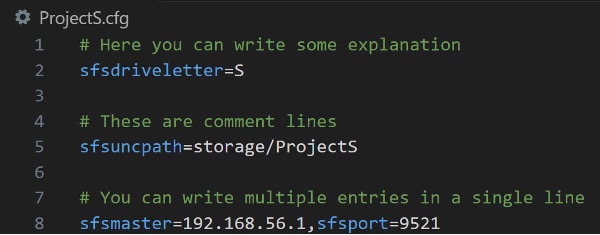
The resulting mount of this example config file will be the same as shown in the Example 2 under section "Extended general options" shown as example.
Further examples
These last examples are present to show some other ways to write arguments for the mount command line. The following commands are equivalent (note it is a merge of some of the previous commands):
sfsmount -H 192.168.1.158 -P 9421 -D S -S /data/ProjectS -o cacheexpirationtime=10000 -o readaheadmaxwindowsize=32768 -o readworkers=16 -o maxreadaheadrequests=16 -o sfschunkserverwavereadto=150 -o bandwidthoveruse=0.5 --uid 999 --gid 999 -o sfsumaskfile=111 -o sfsumaskdir=023
sfsmount -H 192.168.1.158 -P 9421 -D S -S /data/ProjectS -o cacheexpirationtime=10000,readaheadmaxwindowsize=32768,readworkers=16 -o maxreadaheadrequests=16,sfschunkserverwavereadto=150 -obandwidthoveruse=0.5 --uid 999 --gid 999 -o sfsumaskfile=111,sfsumaskdir=023
sfsmount -H 192.168.1.158 -P 9421 -D S -S /data/ProjectS -o CacheExpirationTime=10000 -o ReadaheadMaxWindowSize=32768 -o ReadWorkers=16 -o MaxReadaheadRequests=16 -o SFSChunkserverWaveReadTO=150 -o BandwidthOveruse=0.5 --UiD 999 --gId 999 -o SfSuMaSkFiLe=111 -o sfsumaskdir=023
sfsmount -H 192.168.1.158 -P 9421 -D S -S /data/ProjectS -o CacheExpirationTime=10000 -o ReadaheadMaxWindowSize=32768,ReadWorkers=16,MaxReadaheadRequests=16 -o SFSChunkserverWaveReadTO=150,BandwidthOveruse=0.5 --UiD 999 --gId 999 -o SfSuMaSkFiLe=111 -osfsumaskdir=023
In other words, the "-o" particle could be disposed and replaced by a comma, and the arguments that should be preceded by it can be joined. Also, the space in between the "-o" and the option itself could be removed, if the option is not a sequence of options comma separated. The names of the options can be written using any case, note it does not apply to:
- keywords ("-H", "-P", "-D")
- the "-o" particle
- the parameters ("/data/ProjectS")
Both of these advanced manners to write options cann be merged, such as the last example. Any command line that does not suffice the expected pattern will display an error message with the wrong/misspelled option, and prevent the mount start.
Other options
| Option | Description |
|---|---|
| -o sfscleanacquiredfilesperiod=SEC | defines the interval, in seconds, at which the checker function runs to release unused acquired files. (default: 0). |
| -o sfscleanacquiredfilestimeout=SEC | defines the lifetime limit, in seconds, for an acquired file. If a file is not used within this time frame, it is considered unusedand eligible for release. (default: 0). |
| -o sfsloglevel=LEVEL | set logging level to LEVEL. Levels are: trace, debug, info, warn, err, critical, off. (default: warn). |
| -o sfslogflushlevel=LEVEL | set level of the automatic flush of the logs to LEVEL (default: err). Log levels are the same of sfsloglevel option. |
| -o sfsignoreutimensupdate=0|1 | Advanced: use with caution. Ignore timestamps updates during file creation and writing operations. Targets fast creation of small files, but causes timestamp metadata loss (default: 0). |
The previously shown options are some of our actual "Other options" batch. Remaining ones may be present in other parts of this documentation or in some FAQ.
Side note
The descriptions of previous options contain the default and extra comments. The default description appears on the help command response
sfsmount -–help
The rest of the description has been added especially for the documentation. The command
sfsmount -V
displays the version info.
SFSMount Manager
SFSMount Manager is a command line application that is used for monitoring latest statuses from Windows client instances on the same Windows machine environment.
This tool provides as main functionalities listing and disconnecting current Windows client instances with some additional options.
When executing complete SaunaFS installation on Windows OS, this binary is also added as part of it.
Usage
| Option | Description |
|---|---|
--list | List client instances with current statuses. |
--help | Show help information. |
--disconnect <ID> | Disconnect a specific client instance identified by <ID>. |
--disconnect --all | Disconnect all client instances. |
--disconnect --invalid | Disconnect invalid client instances (clients not connected to a master server). |
These are current possible actions that can be performed by the SFSMount Manager. All of these options request info from status files generated by Windows client instances. These files contains following info:
-
MOUNTID: The clients mount point identifier, which has format<drive>:<mountpoint>. -
PID: Denotes the process id associated with the client process. It is used for stopping client when needed. -
MDS_ON: Has value 'YES' if metadata server associated to client is connected, 'NO' otherwise. -
MDS: Metadata server ip address. -
SCHEDULED: Has value 'YES' if client process is scheduled, 'NO' otherwise. -
MOUNTPOINT: Represents client's mountpoint path. -
TIME: To represent time elapsed in milliseconds since the epoch . -
STATUS: This value can be of four different forms:INVALID: When client is running but no master server is connected to it.SCHEDULED: Client has been scheduledDISCONNECTED: Client has been disconnected more than 5 seconds since last time its status was updated on its corresponding status file.WORKING: When client is running and none of above cases happend.
Example 1
.\sfsmount -H 192.168.43.180 -D S
.\sfsmount -H 192.168.43.180 -D T
After mounting two separate client instances we can list them and receive the corresponding info associated with them:

Example 2

If we try to disconnect a client process by ID and considering there were the same two instances from last example running, then the result should be:

Example 3
It also possible to disconnect all current client processes and considering there is the same instance from last example running, then the result should be:
SaunaFS Admin Tool
The SaunaFS Admin Tool (saunafs-admin.exe) is a command-line utility designed for monitoring, managing, and administering various aspects of a SaunaFS installation. It provides a unified interface for inspecting system health, managing server components, controlling system behavior, and retrieving operational statistics. Suitable for both routine diagnostics and advanced administrative tasks.
Usage
saunafs-admin COMMAND [OPTIONS...] [ARGUMENTS...]
| Command | Arguments | Description | Extra Options |
|---|---|---|---|
| chunks-health | <master ip> <master port> | Returns chunks health reports in the installation. By default, all reports are shown. In replication and deletion states, the column means the number of chunks with number of copies specified in the label to replicate/delete. |
|
| info | <master ip> <master port> | Prints statistics concerning the SaunaFS installation. |
|
| iolimits-status | <master ip> <master port> | Prints current configuration of global I/O limiting. |
|
| list-chunkservers | <master ip> <master port> | Prints information about all connected chunkservers. |
|
| list-defective-files | <master ip> <master port> | Lists files which currently have defective chunks. |
|
| list-disks | <master ip> <master port> | Prints information about all connected chunkservers. |
|
| list-disk-groups | <master ip> <master port> | Prints disk groups configuration in chunkservers. | |
| list-goals | <master ip> <master port> | List goal definitions. |
|
| list-mounts | <master ip> <master port> | Prints information about all connected mounts. |
|
| list-metadataservers | <master ip> <master port> | Prints status of active metadata servers. |
|
| list-tasks | <master ip> <master port> | Lists tasks which are currently executed by master. | |
| manage-locks | <master ip> <master port> [list/unlock] [flock/posix/all] | Manages file locks. |
|
| metadataserver-status | <master ip> <master port> | Prints status of a master or shadow master server. |
|
| ready-chunkservers-count | <master ip> <master port> | Prints number of chunkservers ready to be written to. | |
| promote-shadow | <shadow ip> <shadow port> | Promotes metadata server. Works only if personality 'ha-cluster-managed' is used. Authentication with the admin password is required. | |
| stop-master-without-saving-metadata | <master ip> <master port> | Stop the master server without saving metadata in the metadata.sfs file. Used to quickly migrate a metadata server (works for all personalities). Authentication with the admin password is required. | |
| reload-config | <master ip> <master port> | Requests reloading configuration from the config file. This is synchronous (waits for reload to finish). Authentication with the admin password is required. | |
| save-metadata | <metadataserver ip> <metadataserver port> | Requests saving the current state of metadata into the metadata.sfs file. With --async, fails if the process cannot be started (e.g., already in progress). Without --async, fails if the process cannot be started or if it finishes with an error. Authentication with the admin password is required. |
|
| stop-task | <master ip> <master port> <task id> | Stop execution of task with the given id. | |
| list-sessions | <master ip> <master port> | Lists all currently open sessions. | |
| delete-session | <master ip> <master port> <session_id> | Deletes the specified session. | |
| dump-config | <master ip> <master port> | Dumps the configuration files of the master server. Authentication with the admin password is required. |
|
Example 1
Assuming that we have a master server running at IP address 192.168.1.158 and listening for client communication requests on port 9421, let's say we also have a client mounted with the following command:
C:\> sfsmount -H 192.168.1.158 -D T
To check the number of active sessions, you can use the saunafs-admin command to request this information from the master server:
C:\> saunafs-admin list-sessions 192.168.1.158 9421
The output should look like this:
Session ID: 5
IP: 192.168.1.158
Open files: 0
This output shows the list of active sessions, which in this case is one because we only started one client. This output includes the session ID assigned by the master server to identify each client, the client's IP address, and the number of currently open files in that session.
Example 2
To check the list of currently mounted drives, you can use the saunafs-admin command to request this information from the master server:
C:\> saunafs-admin list-mounts 192.168.1.158 9421
The output should look like this:
session 5:
ip: 192.168.1.158
mount point: T:
version: 4.10.0
root dir: /
root uid: 0
root gid: 0
users uid: 999
users gid: 999
read only: no
restricted ip: yes
ignore gid: no
all can change quota: no
map all users: no
This output provides detailed information about the mounted session, including the session ID, client IP address, mount point (drive letter), client version, root directory, user and group IDs, read-only status, IP restrictions, and other mount-related options.
SaunaFS Command Tool
The SaunaFS Command Tool is an open prompt that can be used in a SaunaFS mounted file system in order to perform SaunaFS-specific operations.
Usage
saunafs <tool name> [options]
SaunaFS Tools Overview
| Tool Name | Extra options | Description |
|---|---|---|
| getgoal | [-nhHr] name [name ...] | Get objects goal (desired number of copies). |
| setgoal | GOAL name [name ...] | Set objects goal (desired number of copies). |
| gettrashtime | [-nhHr] name [name ...] | Get objects trashtime (how many seconds file should be left in trash). |
| settrashtime | [-nhHr] SECONDS[-|+] name [name ...] | Set objects trashtime (how many seconds file should be left in trash). |
| geteattr | [-nhHr] name [name ...] | Get objects extra attributes. |
| seteattr | [-nhHr] -f attrname [-f attrname ...] name [name ...] | Set objects extra attributes. |
| deleattr | [-nhHr] -f attrname [-f attrname ...] name [name ...] | Delete objects extra attributes. |
| checkfile | [-nhH] name [name ...] | Checks and prints number of chunks and number of chunk copies belonging to specified file(s). |
| fileinfo | name [name ...] | Show files info (shows detailed info of each file chunk). |
| appendchunks | dstfile name [name ...] | Append file chunks to another file. If destination file doesn't exist then it's created as empty file and then chunks are appended. |
| dirinfo | [-nhH] name [name ...] | Show directories stats. |
| filerepair | [-nhHc] name [name ...] | Repair given file. Use it with caution. It forces file to be readable, so it could erase (fill with zeros) file when chunkservers are not currently connected. |
| makesnapshot | [-of] src [src ...] dst | Makes a "real" snapshot (lazy copy, like in case of appendchunks) of some object(s) or subtree (similarly to cp -r command). |
| repquota | [-nhH] (-u <uid>|-g <gid>)+ <mountpoint-root-path>; [-nhH] -a <mountpoint-root-path>; [-nhH] -d <directory-path> | Summarize quotas for a user/group/inode or all users and groups. |
| setquota | (-u <uid>|-g <gid> |-d) <soft-limit-size> <hard-limit-size> <soft-limit-inodes> <hard-limit-inodes> <directory-path> | Set quotas for a user/group/inode. |
| rremove | name [name ...] | Recursive remove. |
| help | [tool] | Can be used for getting usage description for an specific tool name. |
Extra info for tool commands extra options
| Tool Name Extra Option | Description |
|---|---|
| -n | Show numbers in plain format. |
| -h | Show "human-readable" numbers using base 2 prefixes (IEC 60027). |
| -H | Show "human-readable" numbers using base 10 prefixes (SI). |
| -r | Do it recursively. |
| -GOAL | Set goal to given goal name. |
| SECONDS+ | If trashtime is smaller than given value, increase trashtime to given value. |
| SECONDS- | if trashtime is bigger than given value, decrease trashtime to given value. |
| SECONDS | Just set trashtime to given value. |
| -f attrname | Specify attribute to set. |
| -c | Restore to previous version if applicable, never erase. |
| -o, -f | Allow to overwrite existing objects. |
Deprecated Tools
| Deprecated Tool | Equivalent | Description |
|---|---|---|
| rgetgoal | getgoal -r | Recursive version of getgoal tool. |
| rsetgoal | setgoal -r | Recursive version of setgoal tool. |
| rgettrashtime | gettrashtime -r | Recursive version of gettrashtime tool. |
| rsettrashtime | settrashtime -r | Recursive version of settrashtime tool. |
To execute its operations, this tool, when run in a SaunaFS filesystem, connects to the corresponding master server and requests the required information accordingly. If executed outside a SaunaFS-mounted filesystem, it will retry communicating with the master server until a 15-second timeout is reached.
For the following examples, let's assume there is a default mounted client with the following command:
sfsmount -H 192.168.1.158 -P 9421 -D S
This command creates a drive mounted on the letter S: with the SaunaFS filesystem. The IP address 192.168.1.158 must correspond to a SaunaFS master server that is actively listening for incoming client connections on port 9421.
Example 1
It is possible to use the saunafs command for requesting the corresponding goal for an specific file:
S:\> saunafs getgoal .\file1.txt
Should produce the following output specifying the file and its goal:
Example 2
It is also possible to make snapshots of existing files and folders:
S:\> saunafs makesnapshot .\file1.txt .\file1_snapshot.txt
Which should produce the following output:
In the last case, the snapshot should produce a file with the same size and chunks than the source file or folder. This can be checked by using the fileinfo functionality from the saunafs command:
S:\> saunafs fileinfo .\file1.txt
S:\> saunafs fileinfo .\file1_snapshot.txt
Example 3
As mentioned before, it is not possible to use the saunafs command on a file system outside SaunaFS. This could lead the client to wait for communicating to master, which never happens and should output the following output after 15 seconds:
SaunaFS Right-click Context Menu
The SaunaFS rick-click context menu options is another way to use the functionalities from the saunafs command with the context menu that is display on Windows when right-clicking a file, folder, drive, or folder background.
Example 1
When right-clicking on a file, it could display for instance, the corresponding fileinfo result.
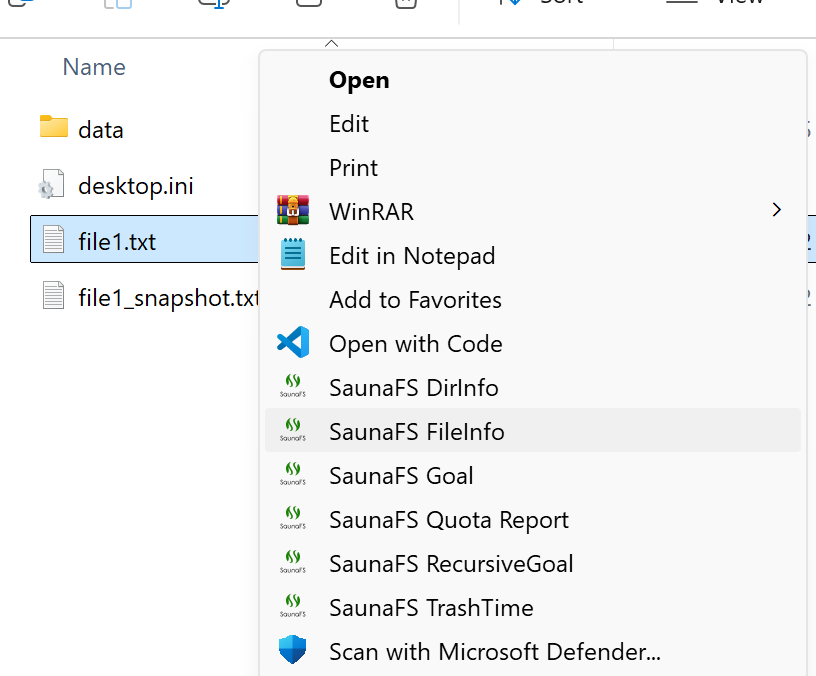

Example 2
It is also possible to display the dirinfo of a folder by using this feature.
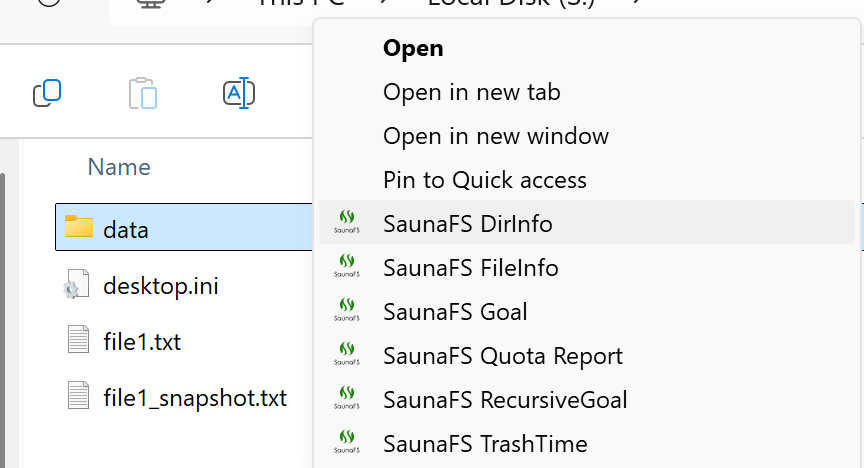
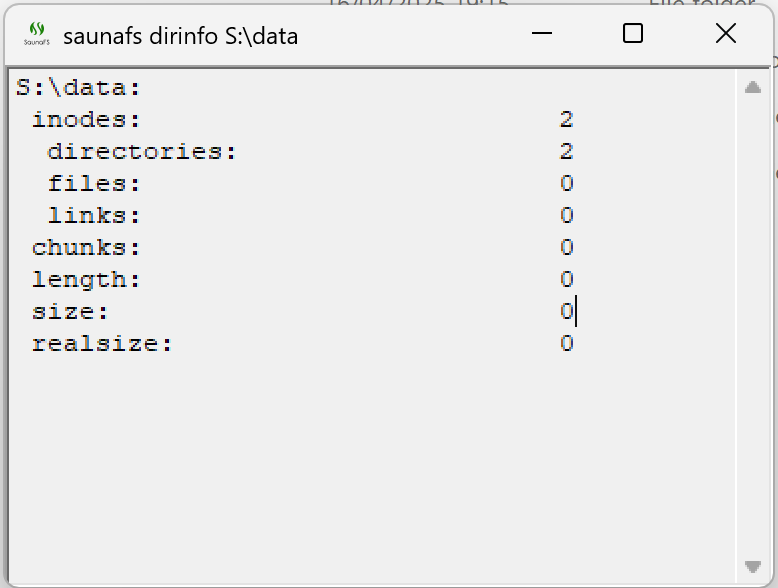
Example 3
This is an example on how to get the dirinfo of a mounted SaunaFS drive.
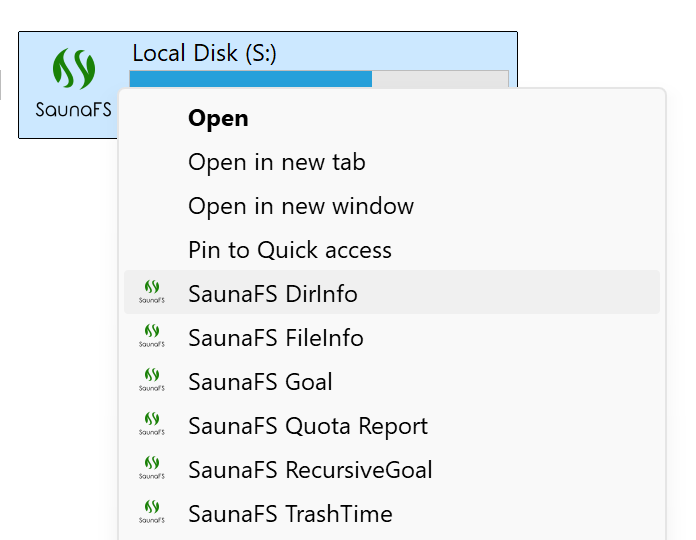

User-wise behavior
It may be troublesome in some cases the expected behavior of the Windows Client when mounted using different users. For instance, consider the case of been able to launch commands from the current user (non-elevated prompt), current user in Admin mode (elevated prompt) and SYSTEM user.
The behavior should be the following:
- a letter mounted by current user would only be visible to the current user (including moving to the mounted path, accessing it through Explorer or else).
- a letter mounted by current user in Admin mode would only be visible to the current user in Admin mode, which means that won't be accesible by regular Explorer and won't be reachable through non-elevated prompt.
- a letter mounted by SYSTEM user would be visible by every user.
- if the current user has already mounted a letter and the SYSTEM user mounts the same one, then the letter would continue displaying the first mount content. If the first mount process ends, then the displayed content would be the SYSTEM user mount.
- if the SYSTEM user has already mounted a letter and the current user tries to mount the same one, you should receive the following error:
Cannot create WinFsp-FUSE file system: mount point in use.. - two different users should be able to mount the same letter at the same time in the same machine, unless some other conflict exists.
The mounts using persistent mount options are SYSTEM user ones (as mentioned in its section) though could be run from elevated prompt.
FAQs
Why can't AJA see my S: drive, only C:?
AJA only recognizes drives mounted as network drives. To ensure AJA can see your drives, you should mount them using the -o sfsuncpath=PATH option. For example, use -o sfsuncpath=server/drive to mount your drive as a network drive. Note that AJA does not recognize drives mounted as regular drives from the SYSTEM user.
Why the client is failing to mount some subfolder of the storage?
When using sfssubfolder option, it needs to be guaranteed that the subfolder represents a valid namespace, i.e, the folder exists.
Otherwise the client will not be able to export the folder. Additionally, the permissions for the folder need to match the sfsuid used to start the client.
Summarizing, before exporting a subfolder, the following steps should verified:
- The subfolder exists, otherwise it needs to be created.
- Assign correct permissions to the user
UID(default 1000) provided (parametersfsuid=UID) that will write/read the folder, i.e., update folder permissions usingchown UID. - Start the Windows Client.
Windows Client can also be used to create new subfolders by following the steps below:
- Start the Windows Client using options
sfsuid=UIDandsfsgid=GIDto mount the root folder ("/") or an ancestor folder containing the path where the new subfolder will be created. For instance, to create folder "/storage/volume01", the client can mount "/storage" subfolder. - Create the desired new folder, for example, "/storage/volume01".
- Stop the client and start it using option
sfssubfolder=/storage/volume01.
Note: This works if the ancestor folder, i.e., "/storage" folder has write permissions for other group.
Why my IIS server is not able to load the data from storage?
The IIS server performs its queries for data through the Windows Client with their very own specific user. Until now, that user has been translated to the uid 17. To confirm this, please check the output of the ".oplog" hidden file (type .oplog at the root of the filesystem) while trying to load the page. That user is from the range of users which are not local (less than 196608) and is not treated like them, which most likely is the cause of the issue. In order to fix the issue, you should provide the sfsallowedusers=17 option (if IIS user is 17).
Why is the client using considerable disk resources if I am not performing any operation on the mountpoint?
In case you check the Resource Monitor tool on your Windows machine and notice a situation of unexpected disk resources consumption similar to the image below:

You should check if, when the client was mounted, the enableupdaterstatusthread option was set like this: enableupdaterstatusthread=1. In that case, consider mounting the client again without specifying that option, which is disabled by default. Then you could see a disk usage consumption reduction like this:
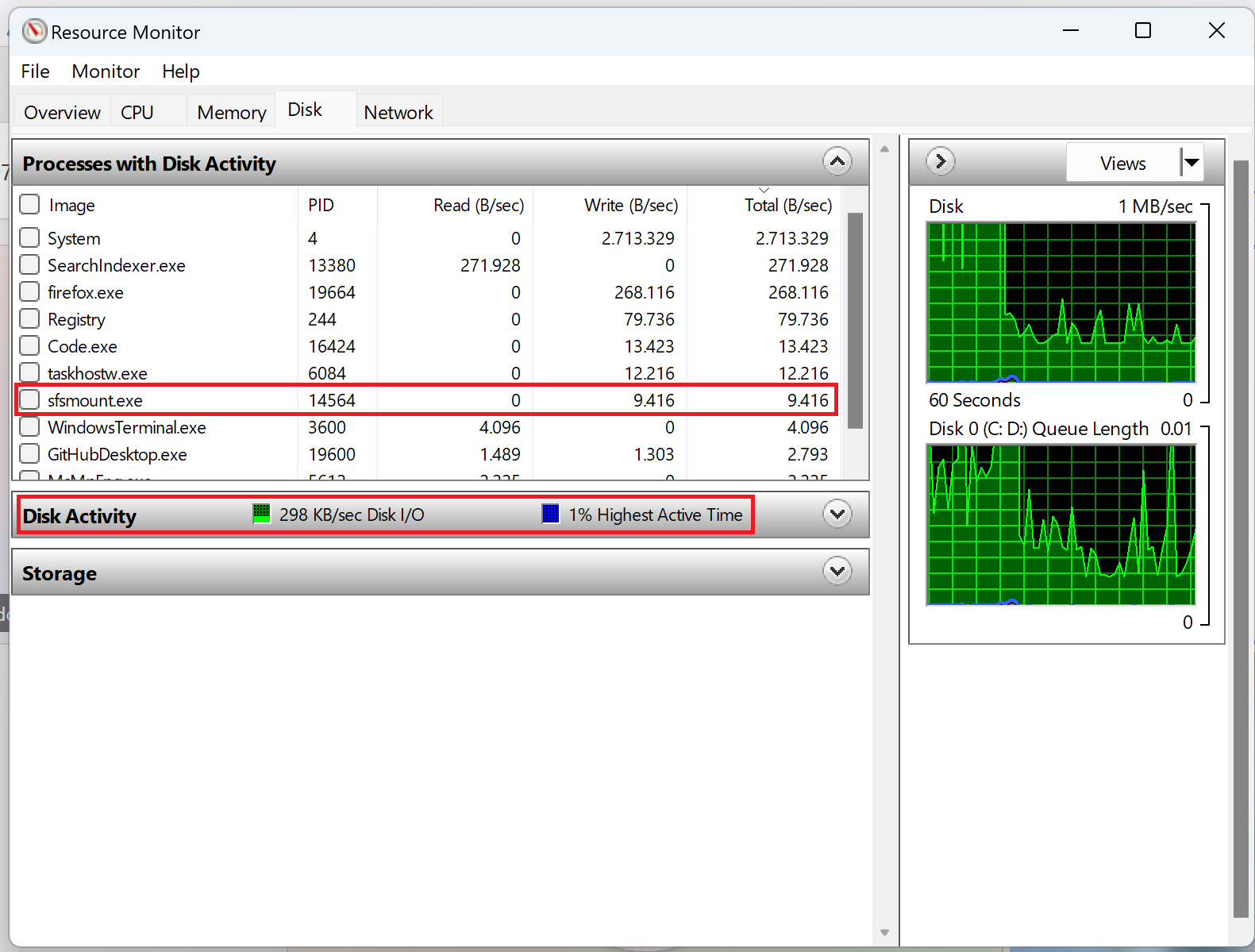
The reason behind this situation is that enableupdaterstatusthread option enables a thread to periodically update the mount status in a file. Enabling this option can cause unexpected and continuous logging to C:\\$LogFile and :\\$Extend\\$UsnJrnl:$J files, which may affect performance on machines with lower capabilities.
This option is only available from SaunaFS Windows Client version v1.1.8. If you are using an older version, consider updating it for avoiding this issue.
Why is the Windows client UNC path option not working?
If you want to start a client as a network drive using the UNC path feature, you might encounter an issue like this:

After this, you might find that it is not possible to access the mounted network drive like this:
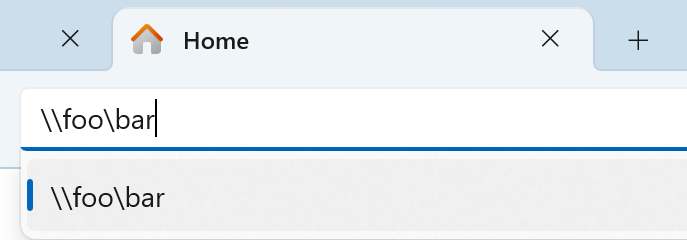
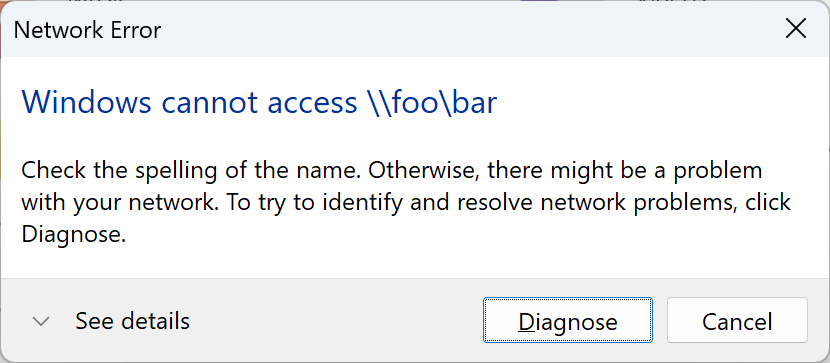
The reason for this situation to happen is that you probably haven't granted enough permissions to the WinFSP registry in the Windows Registry. You can go to the search tab and type "Registry Editor" then you should see something like this:
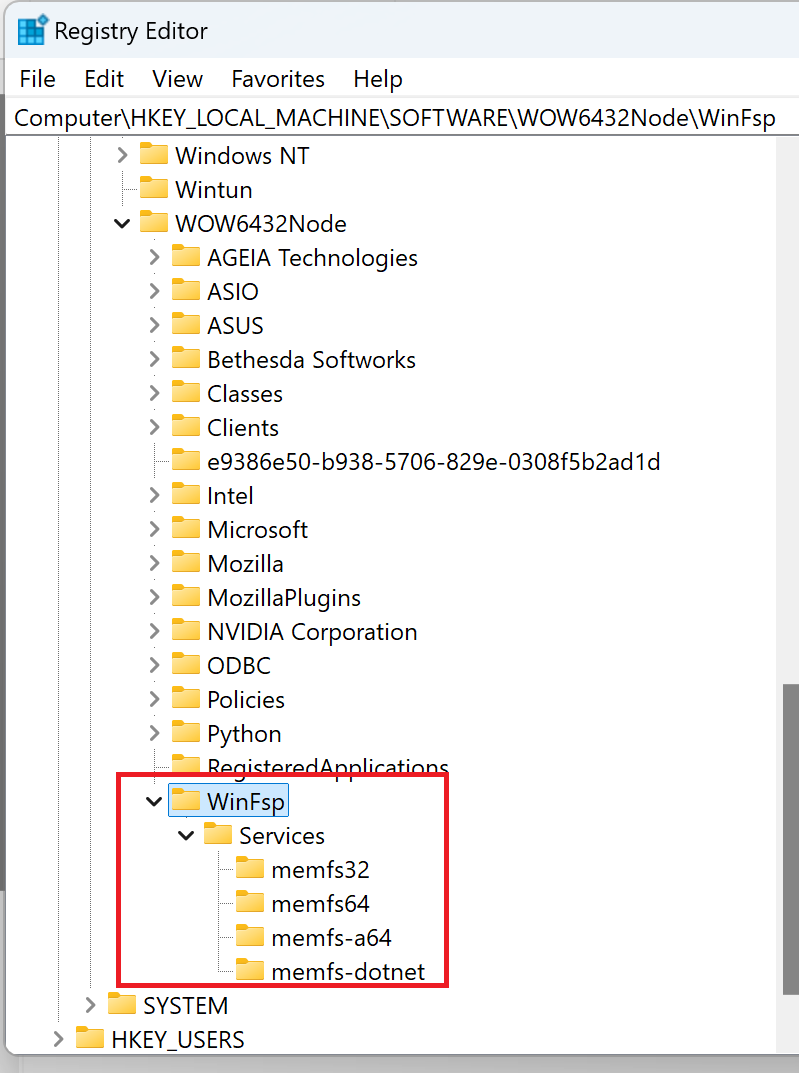
You should then right-click on WinFSP and grant full access to the users on the machine where you are trying to mount the client using the UNC path option.
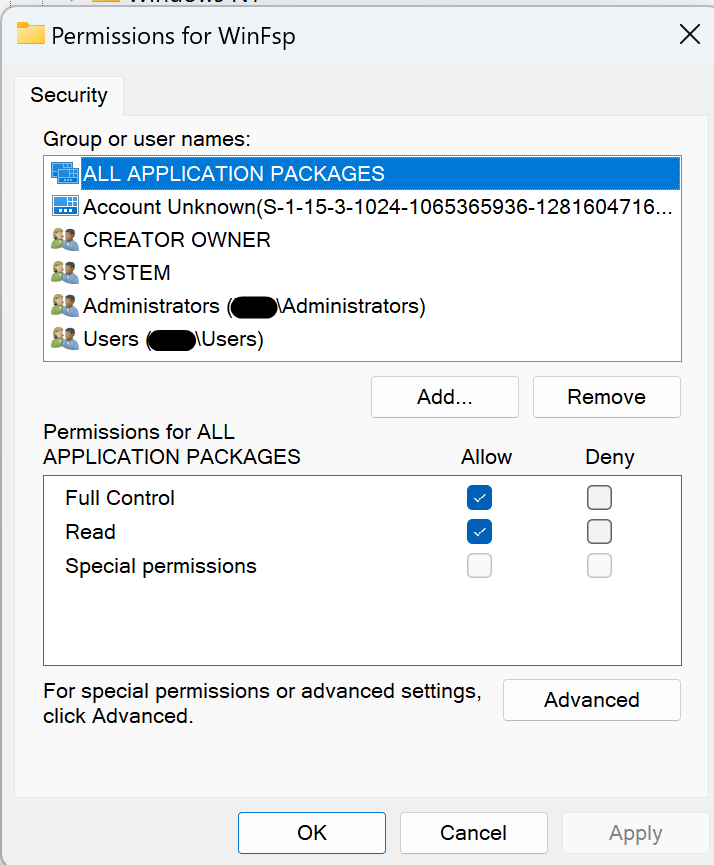
Then, when you try to mount the client with the UNC path feature, the permission error message should be gone:

Finally, when you try to check the resolution of the UNC path, it should work as expected, showing the content of the mount point after typing the UNC path in the Windows Explorer bar.
This issue should have been fixed after installing v1.2.0.
Why can't I write data to a file while the client is running?
When using the Windows client created mount point, you might experience the inability to write data to a file, such as a newly created Notepad file. In this situation, you should first verify that the client is correctly connected to a master server and that there are enough chunkserver disks available to ensure data creation.
For better feedback on the possible error reason for writing operations, you can enable the sfslogwindowsnotificationarea=1 option. This option is disabled by default, but when enabled, it shows the write error reason, the inode of the issue, and the corresponding path of that inode in the Windows notification area. Additionally, you can use the sfsmessagesuppressionperiod option to set the period of message suppression in seconds for logging in the notification area. The following images show a sample of this notification in the Windows environment.
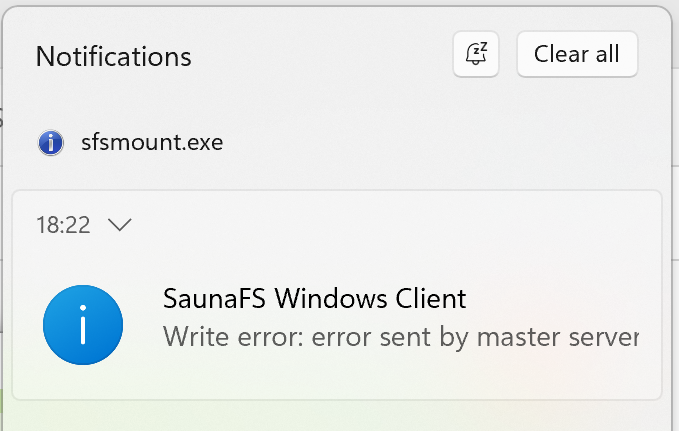
How can I adjust the size of the usable space on a drive according to my needs?
Thanks to changes introduced in version v1.4.2, it is now possible to mount the client in a way that allows filesystem quotas to be considered when determining the current used and total space of a given drive. To do this, you can enable the usequotainvolumesize option by setting it to 1, and then use the saunafs command to configure the quota for the specified drive.
For example, you can mount a client like this:
C:\> sfsmount -H 192.168.1.158 -P 9421 -D S -o usequotainvolumesize=1
This will display a mounted drive like this on Windows:

With a total of 60 GB of usable space.
If you want to limit the mounted drive to support at most 20 GB of usable space, you can run:
S:\> saunafs setquota -d 0 20G 0 0 S:
After applying the quota, the updated drive will show a reduced maximum usable space like this:
As shown, the approximate maximum usable space is now around 20 GB.